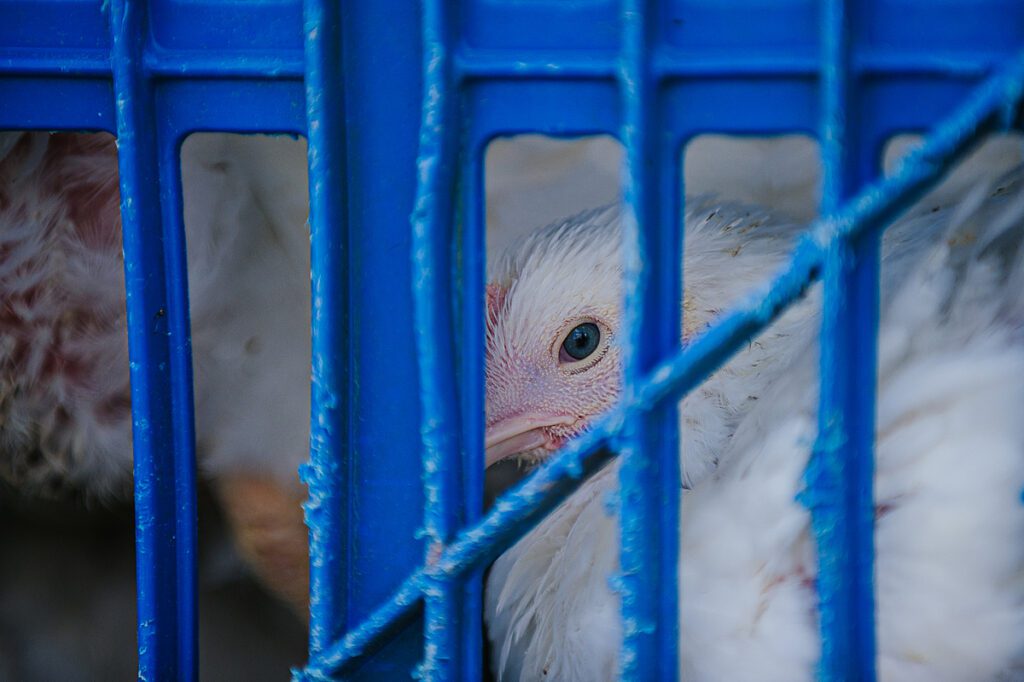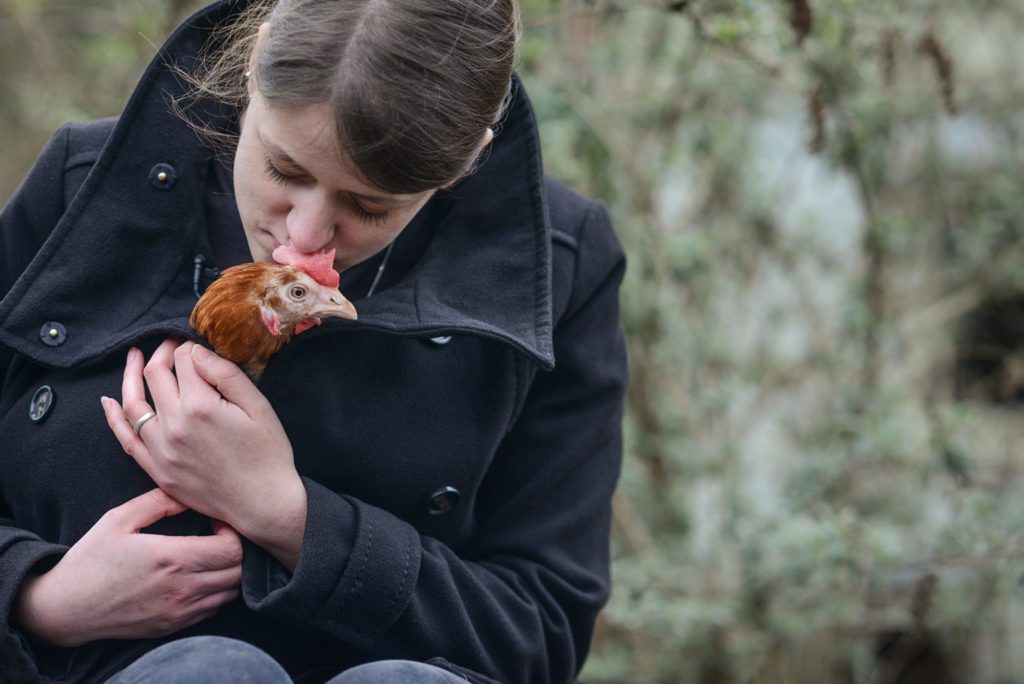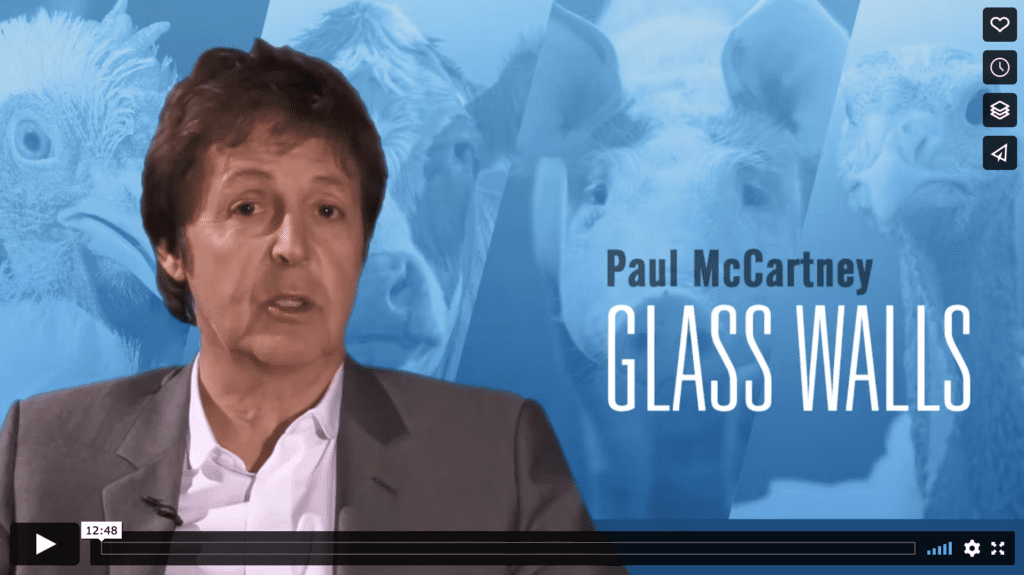


The decision to prioritize our own comfort and convenience by looking away might feel easier, but it comes at a terrible cost.
By David Marten
6 min read
Facebook’s algorithm is considering two sponsored posts that feature the same chicken. In the first post, she is alive and struggling, confined in a tiny cage, on her way to her premature death. In the second, she is dead, beheaded, and roasted. Can you guess which post was approved? It turns out that Meta, the parent company of Facebook, is deceiving its consumers in more ways than one.
There’s a strange and troubling disconnect between the food we’re happy to see on our plate and the true story of the living animal who eventually becomes that food—often under painful and distressing circumstances. A drumstick was once the leg of a living chicken who did not want to die. But Facebook only allows one of these images to be advertised. A clue: It’s the one intended to appeal not to your head or your heart, but rather to your stomach.
Ads are placed on Facebook feeds by animal rights organizations like The Humane League, the group I work for, to raise awareness about the reality of factory farming. These ads depict chickens raised for food (commonly known as broiler chickens) and their experiences on factory farms. But Facebook’s algorithm often rejects those ads under its “sensational content” policy. Facebook requires posts that share “violent” or “graphic content” information and images to come with a content warning, which cannot be included in paid ads.
The miserable, tortured lives endured by chickens raised for human consumption are upsetting from beginning to end. Broiler chickens live under some of the most brutal conditions experienced by any nonhuman animal. When they hatch, chicks are packed on conveyor belts leading to forced immunizations as well as mutilations, which often include severing beaks, toes, and combs without pain relief. They live in indoor sheds among hundreds of thousands of other birds, in cramped and often filthy conditions.
Over the years, the meat industry has bred birds to grow unnaturally large, all so that consumers can get more meat per meal. The birds grow so large, so fast that their bodies can’t support their own weight, resulting in painful conditions and broken bones. Finally, chickens suffer through their final moments in a slaughterhouse, usually after only 47 days of life—drastically shorter than their typical lifespan of up to seven years. Slaughterhouse deaths are frequently haphazard and inhumane. The techniques used to knock out a bird before her death often fail, and many chickens venture wide awake and conscious to their own slaughter.
It’s not a surprise that telling these animals’ stories provokes horror and sadness—it’s not exactly the kind of content you might be excited to see on a morning scroll of your social media feed. I understand the rationale behind Facebook’s sensational content policy. But isn’t it ironic that while Facebook rejects The Humane League’s ads, companies selling chicken products are free to advertise the final result of a broiler chicken’s tragic life?
Cheerful young people celebrate over meals of chicken sandwiches; a family digs into a fried chicken bucket. These ads aren’t just limited to Facebook—you’ll find them everywhere both online and off, from a YouTube ad to a billboard at a bus stop. Facebook and companies like it deem these images as harmless advertising. But underneath the happy feasting lies the grim story of an animal in pain.
The painful truth is that behind the everyday images of meat consumption that most people barely register, cruelty and violence prevail. If more people knew about the reality behind the chicken they eat every day—whether purchased at a fast-food chain or bought from the supermarket—they could play a more active role to end this suffering by making more conscious food or life choices.
If this were to happen, for example, then some people might consider a vegan lifestyle; others could campaign for serious change and reform in the way broiler chickens are raised. It’s part of the reason why animal protection organizations work to open people’s eyes to the ways animals are treated to end up on the table. But the very nature of the violent treatment means that social media algorithms like the ones used by Facebook restrict the ability of organizations like mine to inform people about the cruelty suffered by animals behind the meat they eat for their meals. It’s a catch-22 that chickens and other farm animals are paying for.
It also reveals a broader problem that goes beyond the sponsored posts that Facebook’s algorithm allows animal rights organizations like ours to promote. It’s about the choices we make around our food consumption. Most people are kind and empathetic: Of course, we don’t want to see a chicken in pain over our morning coffee. But that chicken is in pain, whether or not we choose to see her. The decision to prioritize our own comfort and convenience by looking away might feel easier, but it comes at a terrible cost.
If a chicken experiences enough violence that we have to flag her story with a content warning, doesn’t that make it obvious that we should not be putting her through the experience in the first place? Unlike other upsetting content that might be flagged with a warning, the way we treat animals farmed for food is not a failure of the system of industrial agriculture, but rather is a feature of it—one baked right in with the herbs and spices.
That means that it’s not simply Facebook’s algorithm that needs review, nor the question of what makes content palatable. After all, consider the flip side of this coin: Those who understand the truth about how chickens raised for meat are typically treated before their deaths might consider an ad featuring a chicken dinner to be worthy of a content warning. But content warnings alone won’t change anyone’s mind or lead to productive conversations between the two groups triggered by the finished meat product or the story behind it. It also raises larger questions about how we can take more responsibility for the food we consume by being aware of the torture animals go through because of the flawed system that is the meat industry. It will take work to get more people to reconnect those two images—the chicken before her death and the chicken after. And that work is an essential part of reforming the system that encourages cruelty and pain in the name of profit and convenience.
###
David Marten is a senior web developer at The Humane League.
Take action…

Starbucks sources eggs from suffering, abused chickens
“Starbucks is supposed to stand for more than just coffee. It claims to care deeply about its community and social issues. Yet Starbucks doesn’t extend this care to the millions of egg-laying hens suffering in its global supply chain,” writes the Humane League.
“Starbucks refuses to end its support of farms that confine hens in tiny, filthy cages. These cages are so small and packed with birds that the hens can’t do anything that is natural or important to them. Often, their body parts are caught in the caging, which results in fractured or broken bones, deformities, and severe feather loss. Some hens, exhausted or unable to move, are trampled to death by their cage mates.
“Hundreds of companies around the world are ditching cages. Global commitments to end cruel cages are being made by some of the largest companies in the world, including General Mills, Unilever, Nestle, Lidl, Aldi, Wyndham Worldwide, InterContinental Hotels, Aramark, Sodexo, Mondelez, and Compass Group. Even low-end fast food companies and U.S. prisons are moving away from this horrible practice. Starbucks, however, has failed to join this movement towards better treatment of animals globally.”
Urge Starbucks to stop sourcing eggs from abused hens.
ICYMI…

The call of the wild has always been in the chicken’s heart
By Karen Davis
Though chickens are polygamous, mating with more than one member of the opposite sex, individual birds are attracted to each other. They not only “breed”; but they also form bonds, clucking endearments to one another throughout the day. A rooster does a courtly dance for his special hens in which he “skitters sideways and opens his wing feathers downward like Japanese fans,” according to Rick and Gail Luttmann’s book, Chickens in Your Backyard. A man once told me, “When I was a young man I worked on a chicken farm, and one of the most amazing things about those chickens was that they would actually choose each other and refuse to mate with anyone else.”
Sadly, the eggs of these parent flocks are snatched away and sent to mechanical incubators, so the parents never see their chicks. “Breeder” roosters and hens are routinely culled for low fertility, and also because “if a particular male becomes unable to mate, his matching females will not accept another male until he is removed,” explains the book Commercial Chicken Meat and Egg Production.
Little more than a year later, the parents who have survived their miserable life are sent to slaughter just like the chicks they never got to see, raise or protect, as they would otherwise have chosen to do if they were free.
Parting thought…

“If slaughterhouses had glass walls, everyone would be a vegetarian.” —Sir Paul McCartney
Earth | Food | Life (EFL) explores the critical and often interconnected issues facing the climate/environment, food/agriculture and nature/animal rights, and champions action; specifically, how responsible citizens, voters and consumers can help put society on an ethical path of sustainability that respects the rights of all species who call this planet home. EFL emphasizes the idea that everything is connected, so every decision matters.
Click here to support the work of EFL and the Independent Media Institute.
Questions, comments, suggestions, submissions? Contact EFL editor Reynard Loki at [email protected]. Follow EFL on Twitter @EarthFoodLife.